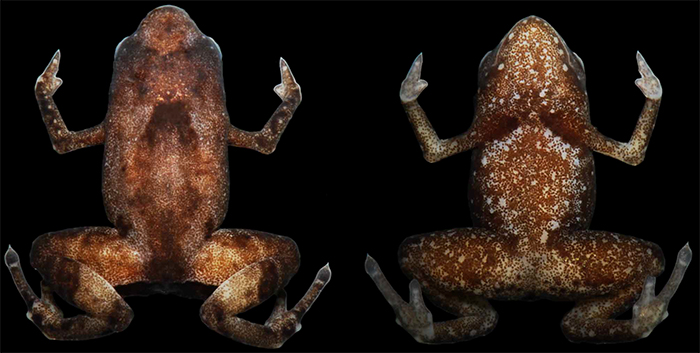A tiny frog only discovered in 2011 is the new smallest vertebrate in the world. Though it’s called a Brazilian Flea Toad, it is actually a frog. At 7 to 8mm long, it is so small that it is near the limit of how small a vertebrate can be. It beats out, by a mere half-millimeter, the previous smallest vertebrate, a frog from Papua New Guinea.
Researchers discovered the Brazilian Flea Toad (Brachycephalus pulex) in Brazil’s Serra Bonita mountains, in the eastern state of Bahia. At first, scientists thought they were toads because of their appearance, hence the name.
It took them years to collect enough individuals to work out an average size. Their tiny size helps them hide in leaf litter from both predators and researchers.
Finally, researchers found enough of them to put together a new study of 46 flea toads. On average, the males are 7.1 millimeters long, while the females are slightly larger, with an average length of 8.15 millimeters. The smallest was only 6.45 millimeters.
The females are a little bigger because of the extra space they need to carry their eggs.
“Identifying the smallest frog in the world has been no easy challenge,” admits study co-author Wendy Bolanos. One of the trickiest parts was examining the genitals of each frog to make sure they only measured adults.

Dorsal and ventral views of the Brazilian Flea Toad. Photo: Napoli et al., 2011
Nothing smaller?
The tiny frogs have several adaptations to help them cope with their stature. They only have three fingers. It seems that there was not enough room for the first and fourth fingers to develop. Similarly, only their spine and brain are bone. The rest of their skeleton is softer cartilage.
Could some even smaller, undiscovered frogs exist? Some scientists believe that it would be almost impossible for a vertebrate to measure less than six millimeters. Less than that, and it would be incredibly difficult to fit in essential organs or for the females to produce enough eggs to maintain a population.
The little frog still has many unknowns. The researchers never heard the frogs making any kind of sound. This, along with their underdeveloped ears, suggests that they are unable to hear. Then how do they find mates and communicate?
Its bright colors may warn predators that it contains toxins and should be left alone. But it’s currently uncertain whether the frog’s skin contains poison or whether the bright warning color is just a devious ploy.






